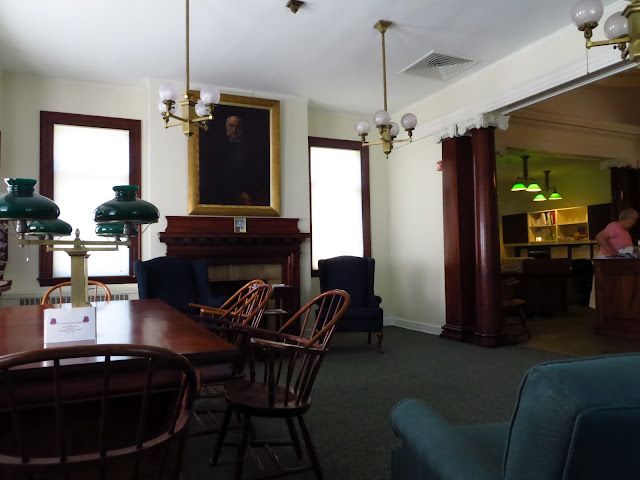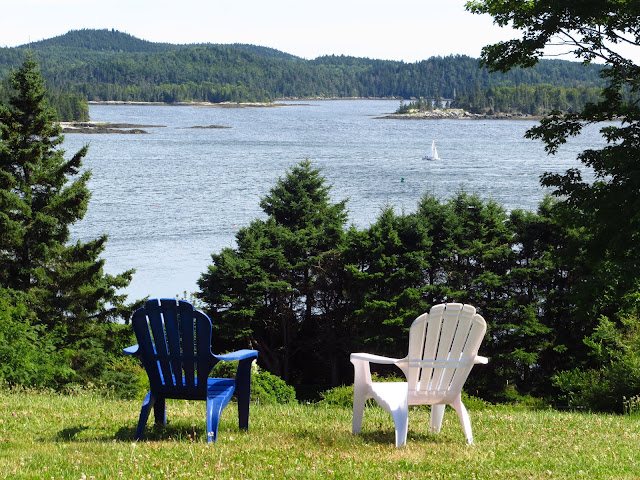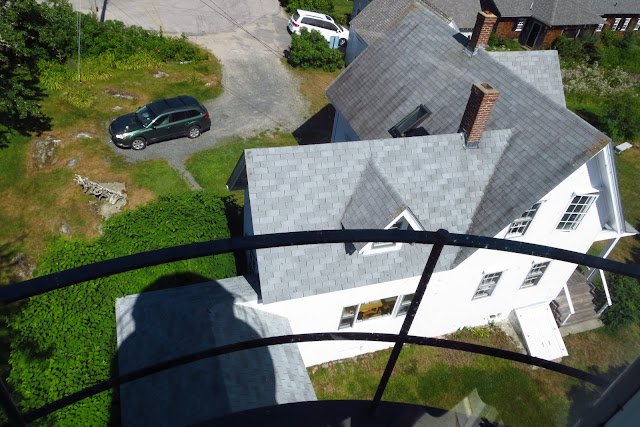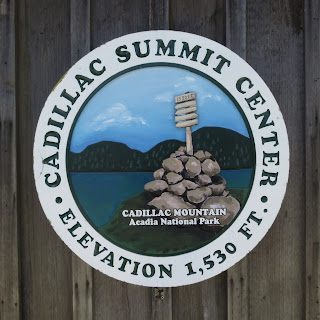Our
first destination was Camden, where the Camden Hills come right down
to the ocean. We got an artistic preview in the Farnsworth Museum of
Art in Rockland, above from Alvan Fisher who in 1852 wanted you to
see that Camden had a dock for steamships (look closely at the center of the painting); and below from Fitz Henry
Lane in 1859, as always with precise depictions of sailing ships.
We
hiked up the closer and less daunting peak, Mt. Battie, 780' high.
The taller one is almost 1400' up, and was actually too long a hike
for us. Mt. Battie was challenge enough, requiring hands as well
as feet to ascend, but the views were well worth it.
The
blueberries were just ripening. These are wild Maine blueberries,
tiny little things though oh, so good! Back in town we passed some
more lobster humor and indeed enjoyed a lobster dinner, Louise the
lobster salad and Jeff the boiled lobster with steamed clams.


Camden is an attractive town with a stunning harbor. If you watch the 1957 movie version of Grace Metalious's notorious book Peyton Place you'll see just how quaint it is. The actual incidents the book is based on had taken place in NH and not that long ago, and in 1957 they had no desire to link themselves any more closely to the book. Camden Maine was happy to have the film shot there -- they had no spouse abuse, incest or oversexed teenagers in Camden, don't you know. The town library even provides an online map to the locations used in the movie, one of which is the Whitehall Inn, where we spent three nights. It became an inn in 1901 when someone bought an 1834 farmhouse, started inviting guests, and kept on adding new wings and eventually a dining room.
Our
next stop was Belfast and a visit and historic house tour with Tyrone and Hubie, who spend
part of the year in a condo unit right down the hall from ours in
Seattle. But they also spend part of the year here, where Hubie
inherited this beautiful brick Federal that has never been sold -- it
has been passed, generation to generation, through his family for almost 200 years! Our lodgings were just out of town. We had our own
little housekeeping cabin with a view of Penobscot Bay. It's the tan one behind the lady walking her dog at
low tide. There's something special about having your own little place for the night, however small it may be, isn't there?
Next
day we stopped at the Penobscot Maritime Museum in Searsport. They
have a small boat workshop that built this canoe from large strips of
birch bark sewn together and caulked much as the Indians have been
doing it for centuries. They also have an impressive collection of
19th century scrimshaw, carvings on whalebone done by sailors whiling
away long hours at sea.




Given
the Japanese culture that permeates our family, we paid particular
attention to some treasures that folks brought back to Searsport
during the days it was a major player in trade with the orient. This
bag was used as decoration at New Years, perhaps with flowers, though
it is made to look like a money bag with the mice running around representing good fortune. The Kutani ware from Kyoto was brought back
by a Searsport woman from her 1890-91 honeymoon in Japan. And sea
captain Frank Pendleton dropped off photographs of himself and his
sons while visiting Yokohama in 1881 and a few days later picked up
this watercolor on silk of himself as a samurai, plus matching
drawings of his sons. It was a sort of 19th century Photoshop
operation, and just as corny!
We
crossed the Penobscot on this new bridge (the old suspension bridge is to come down next year) and by some accounts
officially entered Down East Maine, though some purists insist we
didn't really
get "Down East" until 10 days later when, for one day, we
ventured beyond Mount Desert Island. By going a dozen hilly miles
away from the bridge and busy Rte 1 we certainly got to a scenic and historic place
in Maine, the town of Castine. Our home for two nights was the
115-year-old Pentagoet Inn, where we had a window on Main Street and
the harbor.
Castine is one of those places that helps remind us of two forgotten facts about colonial American history -- that a few places in Maine were settled before the Pilgrims landed in Plymouth, though documentation is sparse; and that over 150 years separate the landing of the Pilgrims at Plymouth and the American Revolution. That's about the same amount of time as has passed from the end of the Civil War to now. During that century and a half there was no consensus where the line was or ought to be between Maine and Canada. When Maine was British and Canada French, that was a life and death question in Castine, and the town was fought over repeatedly, and not only by just the British and the French. Even the Dutch got involved and captured it twice, only to hand it back in peace treaties. Perhaps Plymouth should have more fame since, once settled, it stayed settled. Life in Castine was so dangerous that it was abandoned several times, for years at a time.
Castine is one of those places that helps remind us of two forgotten facts about colonial American history -- that a few places in Maine were settled before the Pilgrims landed in Plymouth, though documentation is sparse; and that over 150 years separate the landing of the Pilgrims at Plymouth and the American Revolution. That's about the same amount of time as has passed from the end of the Civil War to now. During that century and a half there was no consensus where the line was or ought to be between Maine and Canada. When Maine was British and Canada French, that was a life and death question in Castine, and the town was fought over repeatedly, and not only by just the British and the French. Even the Dutch got involved and captured it twice, only to hand it back in peace treaties. Perhaps Plymouth should have more fame since, once settled, it stayed settled. Life in Castine was so dangerous that it was abandoned several times, for years at a time.
 Today
it is a picture postcard town with several homes over 200 years old
and many more close to that. We walked about admiring gardens,
admiring the cosy reading room in the town library with its prominent
portrait of the fellow whose money built it, and admiring the pies
for sale at the weekly farmers market. Nearby were the ubiquitous
Civil War statue on the town green and the Unitarian church with its
spare New England look and its pews, each with its own door,
reserved for individual families in former times.
Today
it is a picture postcard town with several homes over 200 years old
and many more close to that. We walked about admiring gardens,
admiring the cosy reading room in the town library with its prominent
portrait of the fellow whose money built it, and admiring the pies
for sale at the weekly farmers market. Nearby were the ubiquitous
Civil War statue on the town green and the Unitarian church with its
spare New England look and its pews, each with its own door,
reserved for individual families in former times.
Another
stroll took us past several large summer homes built a century ago,
and a lot for sale where the enterprising realtor gave you a preview
of the scenery he had for sale, just the place for you to build your
own castle by the sea.
At
the end of the road was a lighthouse and an unexpected treat -- we
just happened to have arrived on one of the two days a year it is
opened to the public! That staircase was not designed for people
going up and down at the same time! Looking down on the
lighthousekeeper's home, it seemed taller from the top than from the
bottom. It certainly gave us an expansive panorama of Penobscot Bay.
How
to top off a day like that? More lobster. This time "lobster
pie," lobster meat covered with cracker crumbs and baked. And
yes, we were actually a bit cold sitting there in July while the rest
of the country was turning the dial up on their air conditioners, but
we were not about to give up those truly waterfront seats.
In two more days we reached our third location for a one-week stay, Mount Desert Island, or MDI as they write it here. It's twice the size of Staten Island in NY, three times the size of Vashon Island in Seattle's back yard, and about a third of MDI is either owned or managed under conservation easements by Acadia National Park. It's pronounced as if it were Mt. Dessert since the name comes from Samuel de Champlain, who called it "Ile des Monts Deserts," or island of bare mountains, and the French pronunciation of "Desert" has survived. As you'll see, the hilltops are not quite bare, but we're getting ahead of ourselves.
We
again had half of a duplex, this time with the owners next door.
Suze kindly picked up a gallon of milk and a dozen eggs for us before
arrival that were waiting for us in the fridge, and we filled nooks
and crannies in our bike bags plus a folding backpack that Louise
wore from the supermarket in Bar Harbor, the main town on MDI, to our
place 4 miles away in Otter Creek. There she is, admiring the Tarn,
a grass-filled lake along the way. Tod met us with some treats from
his garden, including some super-fresh chard that we devoured that
night. Next day we headed back to Bar Harbor with now empty panniers
and picked up the rest of the groceries for the week.
One of our next expeditions was a ride around Acadia on the Loop Road. It was super-smooth and had relatively little traffic, so was great fun on our unloaded tandem. This mostly one-way road took us to quiet Bubbles Pond, to one pullout looking down on the Porcupine Islands and to others giving views of schooners under sail and rocks taking off into the ocean. What we can't illustrate is the thrill of riding our baggage-lightened bike down gradual descents of 100 to 200 feet, rushing through forests or along jagged shorelines at 35 mph as smoothly as if we were flying. It made those climbs at 6 to 7 mph up the other sides of those hills well worth it. And traffic was no issue as there wasn't much of it, and what there was could pass us easily in the second lane.
We continued along the shore to two of the park's most popular spots, Sand Beach and Thunder Hole. They get so popular that the park service lets cars park in the right hand lane when the parking lots get overwhelmed. Sand Beach is Acadia's only beach, and it amazed us how many folks hung out and even swam there, given that the average July water temperature is in the low 50s, almost as cold as the inside of your refrigerator!
We
sat eating our picnic lunch on the rocks at Thunder Hole, amazed this
time at how many tourists waited in vain for the waves to thunder
there. Unfortunately for them, it was too nice a day, and Thunder
Hole only really wakes up in a good storm, when the waves have some
punch to them.
We
also had some wonderful hikes. LL Bean sponsors a free bus service
for Acadia National Park to the tune of $3 million a year, which made
us feel OK about all we've purchased from them over the years. The
drivers have a culture of friendliness that made you feel welcomed
every time you boarded, and they will stop anywhere they can safely
pull over, including right in front of our rental place! When the
weather was iffy one day we took the bus toward town and then hiked
into Bar Harbor through woods and fields and then long the Shore Path
right to the center of town. We stopped for lunch once again on the
rocky shore, and a crab with a body the size of a child's fist walked
by cautiously.
The
next day was perfect weather so we headed out for our most ambitious
hike, up Cadillac Mountain. It was one of the best hikes we've ever
done!
The
bus took us a mile down the road to the trailhead, and into the woods
we headed on South Ridge Trail. Almost immediately we were
introduced to two special features of this hike, long nearly-flat but
upward-sloping ledges of granite, and cairns of a local design to
guide us on our way. Many trails in the northeast look like the
second photo, a jumble of roots just waiting to twist your ankle, but we
had little of that on our trail today. A mile from the start we got
our first introduction to the third feature of our hike, the views,
starting with a peek out to the Cranberry Islands.
As
we followed the cairns and ledges onward and upward, the views got
incrementally better each time we went a ways then turned around.
Jeff stopped frequently with the camera.
We
stopped for lunch by this pond at a col, or saddle on the ridge, and
by the time we restarted our engines we noticed that we had a lot
more company than when we started.
Getting
close to the top now, and the views are stupendous. But look down
closely, and the blueberries are out again. Can you find more than
the three we see in this photo?
At
last, the summit, the highest point on the East Coast between Florida
and Canada, with views down to Bar Harbor and the Porcupine Islands
again. Plus crowds who have come up by car from the Loop Road. There
was a time when a 4-mile climb by bike up its 7% grade would have
appealed, but we both agree that that day has come and gone.
The
problem remained of how to descend. Going down a mountain is
sometimes harder on the legs than going up, and we decided not to see
if that was the case today. We hitched a ride down to where we could
catch the bus into Bar Harbor, then caught one on the separate line
that ran out to our place.
 But
that evening was the Bar Harbor Music Festival's annual free outdoor
concert in Acadia, and it was being held not far from us. After a
home-cooked supper we waved down the bus once again for the ride to
Blackwoods Campground and easily found the amphitheater where rangers
are usually talking each night about moose, bears or dolphins.
Tonight it was Mozart, Bach and Dvorak, with Gerard Reuter doing a
terrific job as soloist on the Bach Oboe Concerto.
But
that evening was the Bar Harbor Music Festival's annual free outdoor
concert in Acadia, and it was being held not far from us. After a
home-cooked supper we waved down the bus once again for the ride to
Blackwoods Campground and easily found the amphitheater where rangers
are usually talking each night about moose, bears or dolphins.
Tonight it was Mozart, Bach and Dvorak, with Gerard Reuter doing a
terrific job as soloist on the Bach Oboe Concerto.
We did one more day of hiking, and it was another good one. Having come on the free buses, we didn't have to worry about the warning for cars as we looked out over Eagle Lake. We began by walking two miles down one of the carriage roads that John D. Rockefeller had built before he handed his thousands of acres of MDI over to the national park. There are some 45 gently graded and well maintained miles of these roads, open only to horses (with or without carriage), hikers and bikers. They are indeed very popular with cyclists but the section we tried a few days earlier was a little too soft for our ease of mind, given the relatively skinny tires on our tandem.
We alternated between lake views and walks deep in the woods, sometimes on these wonderful split-log footpaths. The trail was occasionally a challenge to find, but sooner or later we always saw one of the blue blazes (paint marks) on a tree up ahead, showing us the way.It was a fungiphile's delight. We lost track of the different kinds of mushrooms and shelf fungus we encountered.




After a short climb and descent we were on Jordan Pond. Oh, an easy trail, we thought on first emerging onto this lakeside path.
 As we passed some trees that beavers had recently cut down, we noticed something else -- our trail had suddenly become quite challenging! But the rock scramble didn't last too long, and then we had almost a mile of those split log boardwalks.
As we passed some trees that beavers had recently cut down, we noticed something else -- our trail had suddenly become quite challenging! But the rock scramble didn't last too long, and then we had almost a mile of those split log boardwalks.We ended our hike at the Jordan Pond House, a place that has been serving popovers and tea since before our grandmothers were born. Since the skies were again a little threatening we opted for lunch inside, but it did stay dry and the many diners on the lawn enjoyed this view past folks picking blueberries to The Bubbles, as the twin mountains across Jordan Pond are called.
We picked the day that weather.com said would have the lightest winds for our sea kayak outing, and that turned out to be our last day on MDI. There was supposedly a 50-50 chance of rain midway through our scheduled trip, but it never appeared. They take up to six tandem kayaks on their tours, but we had only two other boats joining us this day, plus Greg, our guide.
As usual, Louise got the front seat, the opposite of our seating arrangement on the tandem. We paddled around Sheep Porcupine and Burnt Porcupine Islands, and close to Long Porcupine and Bald Porcupine. Never did see any sheep or porcupines, either burnt, bald or long, but we did see three pods of porpoises, all about 200 yards away, and far too shy to be photographed. And lots of oh, so scenic rocks and forests.
We have one more week along the Atlantic. It's been quite a run, sleeping next to or at least within a mile of salt water every night but one since we hopped on the bike in Boston 40 days ago, and the same to come for 9 more nights. We'll share our last exploration of the coast and the start of our inland journey with you in our next posting.
































































































1 comment:
It was fun to read your post. I met you both at the Hannaford grocery store in Bucksport. I'd seen you twice on your bike that day and then in the store! This is familiar territory that you've written about this time. It reminded me that we haven't done some of these things for ages. It seems that visitors to our house dictate our sight- seeing and then we just forget about what is all around us...all of the time! Thanks for the reminder and have a great and safe trip! Cheryl
Post a Comment